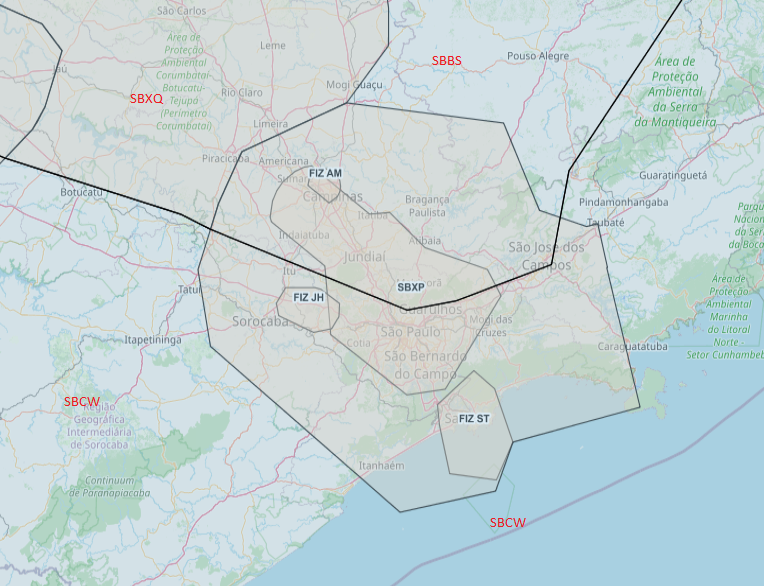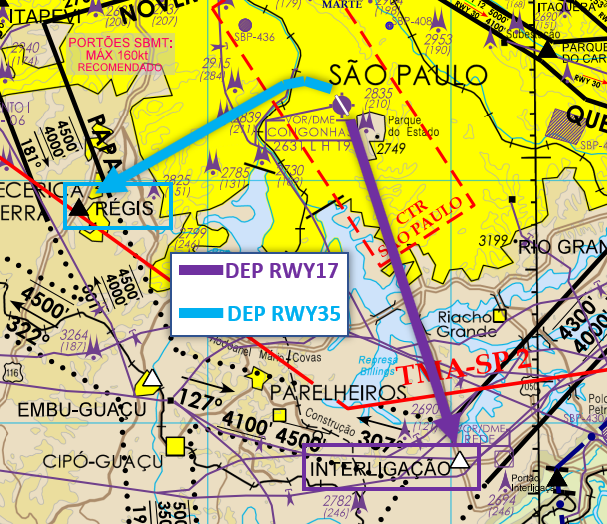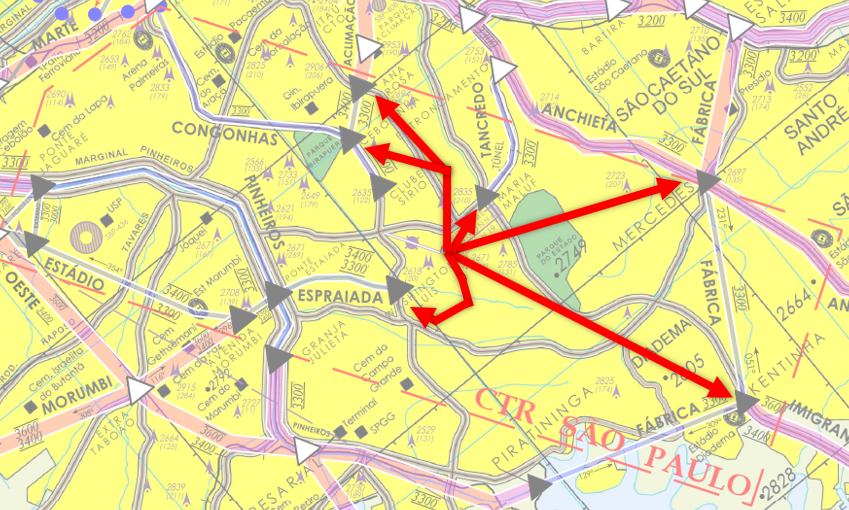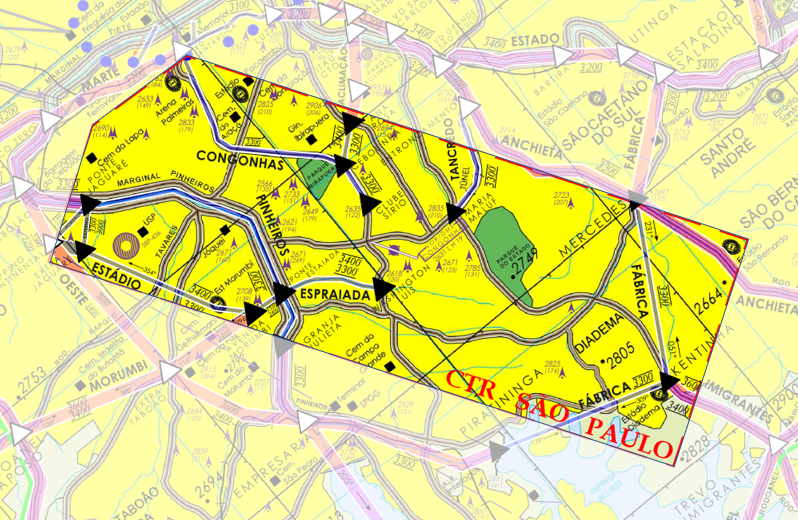Brazil Division
| ICAO | Name | ATC Facilities | SSR | Type of Operation |
|---|---|---|---|---|
| SBSP | Congonhas | TWR / GND / DEL | 0201-0210 | VFR / IFR |
This document describes the procedures that must be followed by the Air Traffic Service (ATS) at Congonhas Airport. The procedures described here are supplementary to the DECEA procedures.
Scope
Those procedures must be followed and applied by all members that are operating at SBSP. Especially the ATC, but not exclusive.
Procedural deviations
Exceptional situations, or unusual ones, can necessitate procedural deviations, or complementary procedures, to be added to the following procedures described in this document.
| Facility | Callsign | Frequência | ID |
| Tower | São Paulo Tower | 118.050 | SP1 |
| Helicopter Control | 118.350 | SP11 | |
| Ground | São Paulo Ground | 121.900 | SP2 |
| Clearance Delivery | São Paulo Clearance | 120.600 | SP3 |
| ATIS | ATIS | 127.650 | ATIS |
| Facility | Callsign | Frequency | ID |
| Approach Control |
São Paulo Control |
129.000 | XP1 |
| VFR Control | 129.500 | XP2 |
| Facility | Callsign | Frequency | ID |
| Center | Curitiba Center | 124.4¹ / 128.400² | CW1 |
| Brasília Center | 126.750 | BS1 |
¹ - primary frequency
² - secondary frequency
Independently if APP SP or ACC CW is online, the SID given in the ATC Clearance must follow the SID table on this category. This procedure aims to reduce coordination between ATC positions and consequently the workload.
Hangars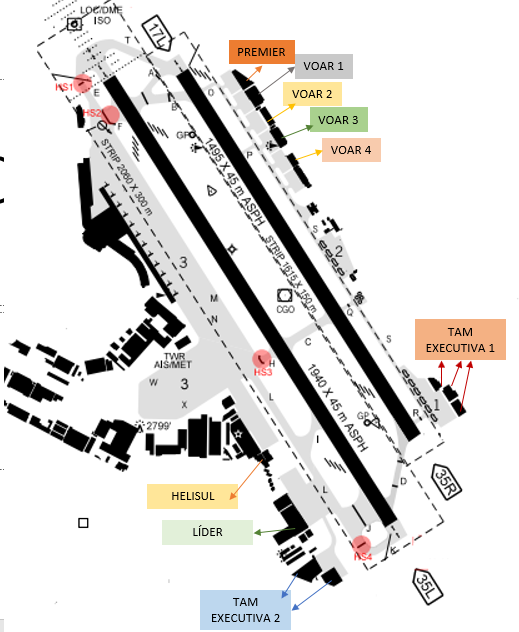
You can find the hangar's name of SBSP on the picture on the right side. Their names can be used during the radiocommunications to facilitate the parking position indication of a specific aircraft.
Parking positions
The APRON 3 positions of SBSP (gate 1 to 16) are destinated to the narrow-body commercial aircraft (A320, B737, E190...). As well as the 17 to 29 position on APRON "A300".
The commercial aircraft that not use the gate (ATR, C208, E145, CRJ...), they must use the position 13 to 29.
The GA aircraft that don't have a parking position in a HANGAR, the APRON 1 and 2 must be used. How there isn't number definided to that position, the expression "position at your discretion" must be used, like the following example:
TWR -> PSEYA, on the ground at 03', vacate the runway to the left and taxi via Q and S. Contact São Paulo Ground at 121.9.
Pilot -> São Paulo Ground, PSEYA, taxiing via Q and S to apron 1.
GND -> PSEYA, continue taxi via Q and S, apron 1, position at your discretion.
Pushback on APRON 3
The M TWY, on MAIN APRON, must be used as an auxiliary taxi line to give agility to the airflow.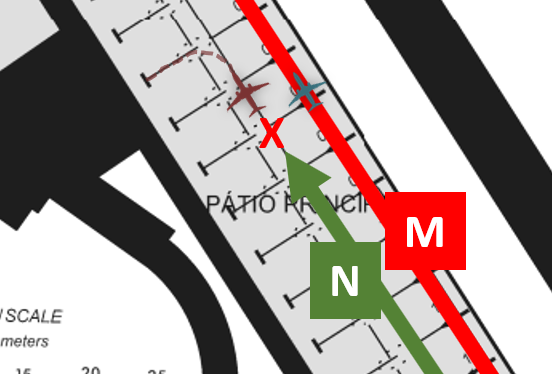
Usually, the parked aircraft on positions 1 to 15 must be instructed to perform the pushback to the "N TWY", as the following example:
Pilot -> GLO9923, stand 5, ready to pushback and start up.
GND -> GLO9923, pushback, and startup approved, limited to the N taxiway, report to taxi.
 The procedure above only can be done when involving two aircraft with a wingspan equal to or less than 36 meters (A320, B737, E190, C25C, LJ45, PA34, or smaller).
The procedure above only can be done when involving two aircraft with a wingspan equal to or less than 36 meters (A320, B737, E190, C25C, LJ45, PA34, or smaller).
The A300 Apron has 3 taxi lines (W, Y, and X) that can be used to the pushback. However, USUALLY, the aircraft parked on positions 17 to 23 will perform pushback to the W TWY; and the aircraft parked on positions 24 to 29 will perform to X TWY.
This procedure, on A300 apron, must be used with aircraft with a wingspan equal to or less than 36 meters, as well as on the main apron.
Helicopters parking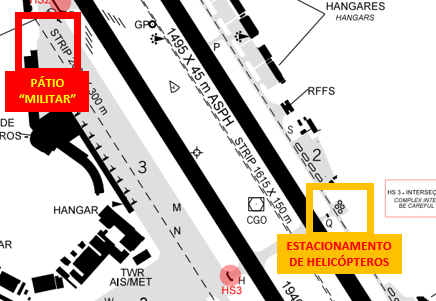
Usually, the helicopters will park on hangars, however, the airport administration has some parking positions for rotative wings. The first one is on the "military" apron (officially known as "patio do pavilhão"), on side of position 1, on the main apron. Those positions are used by military helicopters. The other one, which doesn't have a position on a designated hangar, must park on the helicopter's parking, on the east side of the airport, in front of Q TWY.
Helicopter's departure and landing
Is PROHIBITED the landing/departure operation of helicopters in a place that isn't the runway.
"S" TWY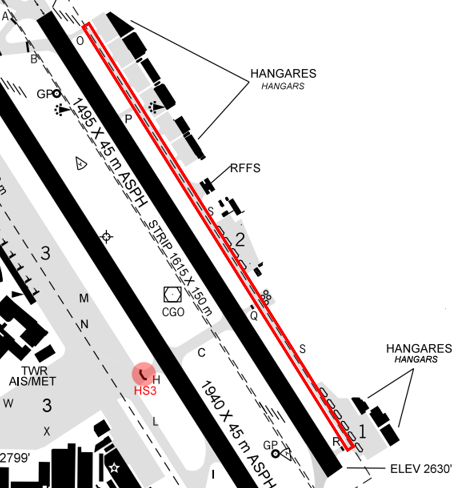
The ATC must observe the following limitations of S TWY (east side of the airport):
- MAX wingspan allowed 24 meters (MAX SPAN 24M); and
- MAX speed of 15kt on TWY.
"O" TWY
The ATC must observe the following limitations on O TWY (east side of the airport):
- MAX wingspan allowed 24 meters (MAX SPAN 24M).
Instruction after landing
When the ACFT is on final, the TWR must ask what will be the parking local of the aircraft. So, the TWR will inform this position to the GND.
The TWR will transmit the following information at the landing momento, in this sequence:
- callsign;
- landing time;
- taxiway to be used to vacate the runway;
- taxi instruction after vacating, to avoind desnecessary occupation in a exit taxiway;
- GND frequency to contact after vacating.
TWR -> PROMX, on ground at 28', vacate to the left, cleared taxi via Q and S, after vacating, contact São Paulo Ground, frequency 121.9.
When the aircraft calls the GND SP, the taxi instruction will be informed again by the GND, and the parking HANGAR (or parking box) will be informed.
GND -> PROMX, cleared taxi via Q and S to VOAR 1 hangar.
The TWY informed by the TWR on landing time must follow those criteria:
| RWY USED | PARKING HANGAR | TAXI INSTRUCTION AFTER VACATING |
|---|---|---|
| RWY 17L | EAST SIDE | Vacating TWY [TWR choice, coordinated with GND] + S TWY |
| WEST SIDE | Vacating TWY | |
| RWY 17R | EAST SIDE | Vacating TWY [TWR choice, coordinated with GND] + M TWY (if the traffic vacate on H, or F TWY), or L TWY (if vacated on I, J or K TWY) |
| WEST SIDE | Vacating TWY | |
| RWY 35R | EAST SIDE | Vacating TWY [TWR choice, coordinated with GND] + S TWY |
| WEST SIDE | Vacating TWY | |
| RWY 35L | EAST SIDE | Vacating TWY |
| WEST SIDE | Vacating TWY [TWR choice, coordinated with GND] + M TWY (if the traffic vacate on H, or F TWY), or L TWY (if vacated on I, J or K TWY) |
Examples:
-
Traffic landing on RWY35L, going to VOAR 3 HANGAR
- "PTOMX, ground at 50', vacate to the right, cleared taxi via B TWY to hold point RWY35R";
-
Traffic landing on RWY17R, going to box 3
- "GLO1829, ground at 51', vacate to the right, taxi via I and M, after vacating, contact SP GND freq 121.9".
NOTE: due to the taxi duration of the traffic vacating the RWY on TWY Q (to the HEL PRKG), or vacating on TWY S (to APRON 1, or to the TAM EXECUTIVA 1), or vacating on TWY E or F (to the "PATIO DO PAVILHAO"), the TWR will instruct the traffic to MONITOR the GND SP on 121.9, following the example:
TWR -> FAB2501, on ground at 28', vacate to the left, cleared taxi via F and M to box 2A, after vacating, monitor São Paulo Ground, frequency 121.9.
Clearance to depart from an intermediate position of RWY
Following a DECEA instruction, always that a clearance/suggestion to depart from an intermediate position is given, the ATC must inform the remaining runway length from that position. To this, observe the image below:

Coordination with APP XP
Ever that the traffic is flying on SBSP traffic pattern, and the XP APP is online, the 360º maneuvering on downwind leg or extending the downwind leg must be coordinated with APP.
Restrictions on Traffic Pattern
Normally, the ARRIVALS to the traffic pattern will obey the entrance contained in the VAC, by the positions:
- Washington Luís;
- Maria Maluf;
- Clube Sírio.
The DEPARTURES will obey what is contained in this chapter, in VFR DEPARTURES.
Next controller online
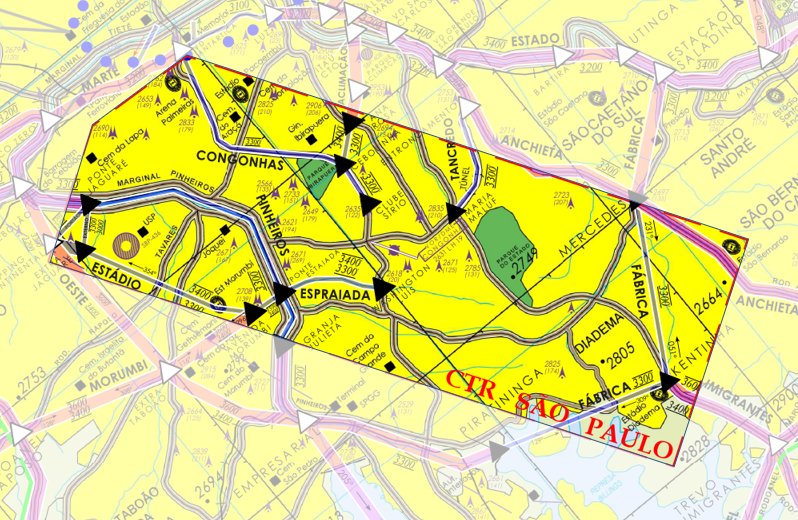
The VFR traffic will, normally, handoff to SP TWR when at 1 minute to join on SAO PAULO CTR.
NOTE: the handoff can occur at another point, as long as previously coordinated between the TWR and APP (or ACC, when APP is offline).
Next controller offline
In case the Sao Paulo APP, or the Curitiba ACC, is offline, the SP TWR must contact the aircraft, by the GUARD frequency (121.5), when the VFR Arriving Traffic is at 2 minutes to join SAO PAULO CTR.
The Helicopter Control Area is located within SAO PAULO CTR (Class D, from GND to 3600FT; and controlled by SP TWR). In real life, this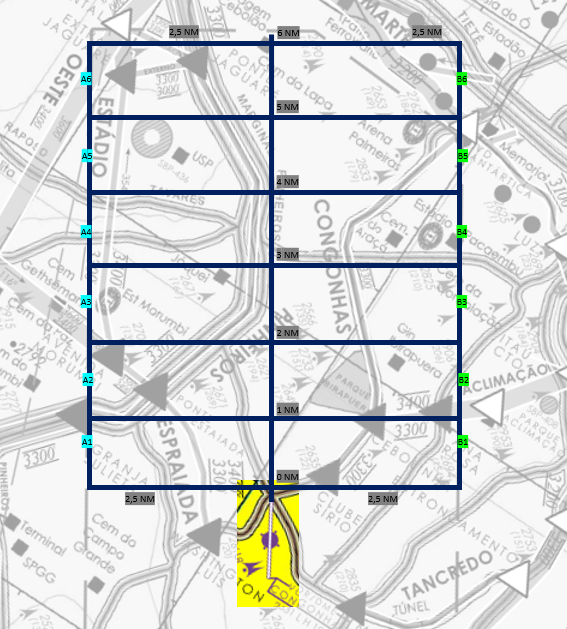 airspace portion is controlled by "HELI CONTROL" (a subdivision of SP TWR), on frequency 118.35. However, due to POSCON's actual traffic characteristics, the HELI CONTROL is deactivated and grouped to SP TWR (this doesn't mean that future activations and/or temporary ones are prohibited).
airspace portion is controlled by "HELI CONTROL" (a subdivision of SP TWR), on frequency 118.35. However, due to POSCON's actual traffic characteristics, the HELI CONTROL is deactivated and grouped to SP TWR (this doesn't mean that future activations and/or temporary ones are prohibited).
This area is a rectangle that begins on THR RWY17 and ends at 6NM on the final. And it has 2,5NM for each side.
In this region, the SP TWR will give clearances and restrictions to avoid the helicopters conflict with the landing traffic of RWY17 or departing of RWY35.
The composite separation can be applied, on the final approach RWY17 and/or on the departure sector of RWY35 of SBSP, between the IFR ACFT and VFR HEL flying in the Helicopter Control Area. The composite separation minimum to be applied is 2,5 NM x 500 FT.
There are a lot of heliports located in this area. To facilitate situational awareness were created numbered sectors of A1 to A6 (left side), and B1 to B6 (right side). So, those quadrants can be used for communication to help the controllers and pilots to localize yourselves. See the following example:
TWR SP -> PTOMS, confirm your destination quadrant.
Pilot -> It's on Birmann 21 building, on the A4 quadrant. Near the Pinheiro marginal.
Another example that we can use the quadrants to traffic information:
TWR SP -> PPMMZ, maintain position on A3 quadrant. I inform an AS50, on the A2 quadrant to B2 inbound.
Each Helicopter Control Area quadrant has 1NM of height and 2,5NM of length.
EVERY HELICOPTER THAT WILL FLY WITHIN HELICOPTER CONTROL AREA must contact the SP TWR. Exceptional cases can occur after PREVIOUS COORDINATION between the involved parts.
Use ever the AISWEB to check the active NOTAM.
NOTE: What must prevail ever is common sense. If the pilot asks not to simulate a NOTAM, and this won't disturb other simmers, this request MUST BE attended! Punctual issues must be reported to our staff team.
Ever the wind intensity at SBSP is less or equal at 5kt, the 17 system must be used as PREFERENTIAL. Except in the cases that operational gains can be provided, and be previously coordinated with XP APP, the 35 system can be used in this case.
Follow those rules when an IFR aircraft starts the missed approach procedure:
- coordinate IMMEDIATELY with the Sao Paulo APP, or Curitiba ACC (when the Sao Paulo APP is offline), when the Sao Paulo TWR notes an aircraft is starting the missed approach;
- don't change, UNDER ANY CIRCUMSTANCES, the missed approach procedure; unless the pilot declares intentions to join in the traffic pattern;
- handoff the traffic to Sao Paulo APP, or to Curitiba ACC (when APP is offline), or authorize "frequency change approved" (when Next Controller is offline), ASAP;
- understand the crew workload during this procedure can be increased; causing delayed answers by the pilots.
The Sao Paulo Tower only can receive a flight plan via radio to the SAR operation aircraft, and others one provided for in official DECEA regulation.
NOTE: It equates to Operation SAR, the aircraft on a radio patrol mission.
Due to POSCON limitation, SBSP doesn't have ATIS; so, the TWR must give meteorological information to all departing aircraft, with the following information, and in this sort:
- runway in use;
- wind direction and intensity;
- QNH
- temperature
- visibility, or runway in use RVR; and
- time check
Example:
GLO1817, runway in use 1-7 right, wind 1-4-0º, 8KT, altimeter setting 1-0-1-2, temperature 2-8º, visibility 8km, time check 5-6'.
| # | Date | Description | Author |
|---|---|---|---|
| - | 20MAR22 | Criação do documento | Juvenal Gomes (1025243) |

